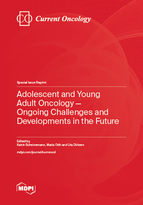Adolescent and Young Adult Oncology—Ongoing Challenges and Developments in the Future
A special issue of Current Oncology (ISSN 1718-7729). This special issue belongs to the section "Childhood, Adolescent and Young Adult Oncology".
Deadline for manuscript submissions: closed (30 July 2023) | Viewed by 24044
Special Issue Editors
Interests: pediatric neurooncology; survivorship and long-term follow-up; AYA oncology
Interests: survivorship and long-term follow-up; oncopolicy; AYA oncology
Interests: translational research in bone sarcoma of young people; academia initiated clinical trials in bone sarcoma of young people; late effects and prevention
Special Issues, Collections and Topics in MDPI journals
Special Issue Information
Dear Colleagues,
The care of adolescents and young adult cancer patients remains a challenge for all healthcare providers as they neither fit into the pediatric nor the adult oncology world.
For this Special Issue on "Adolescent and young adult oncology—ongoing challenges and developments in the future", the aim is to present the full range of issues and topics within the AYA cancer world, including its current status but also future developments.
This Special Issue aims to look at the following main topics: tumor spectrum; treatment and treatment protocols; models of care; and survivorship and long-term follow-up, especially the psychosocial and economic impact.
In this Special Issue, original research articles and reviews are welcome. Research areas may include (but are not limited to) the following: treatment for AYA cancer including special entities; outcomes; long-term sequelae including psychosocial, etc.; models of care for AYA oncology; and fertility.
I/We look forward to receiving your contributions.
Prof. Dr. Katrin Scheinemann
Dr. Maria Otth
Prof. Dr. Uta Dirksen
Guest Editors
Manuscript Submission Information
Manuscripts should be submitted online at www.mdpi.com by registering and logging in to this website. Once you are registered, click here to go to the submission form. Manuscripts can be submitted until the deadline. All submissions that pass pre-check are peer-reviewed. Accepted papers will be published continuously in the journal (as soon as accepted) and will be listed together on the special issue website. Research articles, review articles as well as short communications are invited. For planned papers, a title and short abstract (about 100 words) can be sent to the Editorial Office for announcement on this website.
Submitted manuscripts should not have been published previously, nor be under consideration for publication elsewhere (except conference proceedings papers). All manuscripts are thoroughly refereed through a single-blind peer-review process. A guide for authors and other relevant information for submission of manuscripts is available on the Instructions for Authors page. Current Oncology is an international peer-reviewed open access monthly journal published by MDPI.
Please visit the Instructions for Authors page before submitting a manuscript. The Article Processing Charge (APC) for publication in this open access journal is 2200 CHF (Swiss Francs). Submitted papers should be well formatted and use good English. Authors may use MDPI's English editing service prior to publication or during author revisions.
Keywords
- AYA oncology
- treatment
- models of care
- long-term follow-up
- survivorship
- fertility








